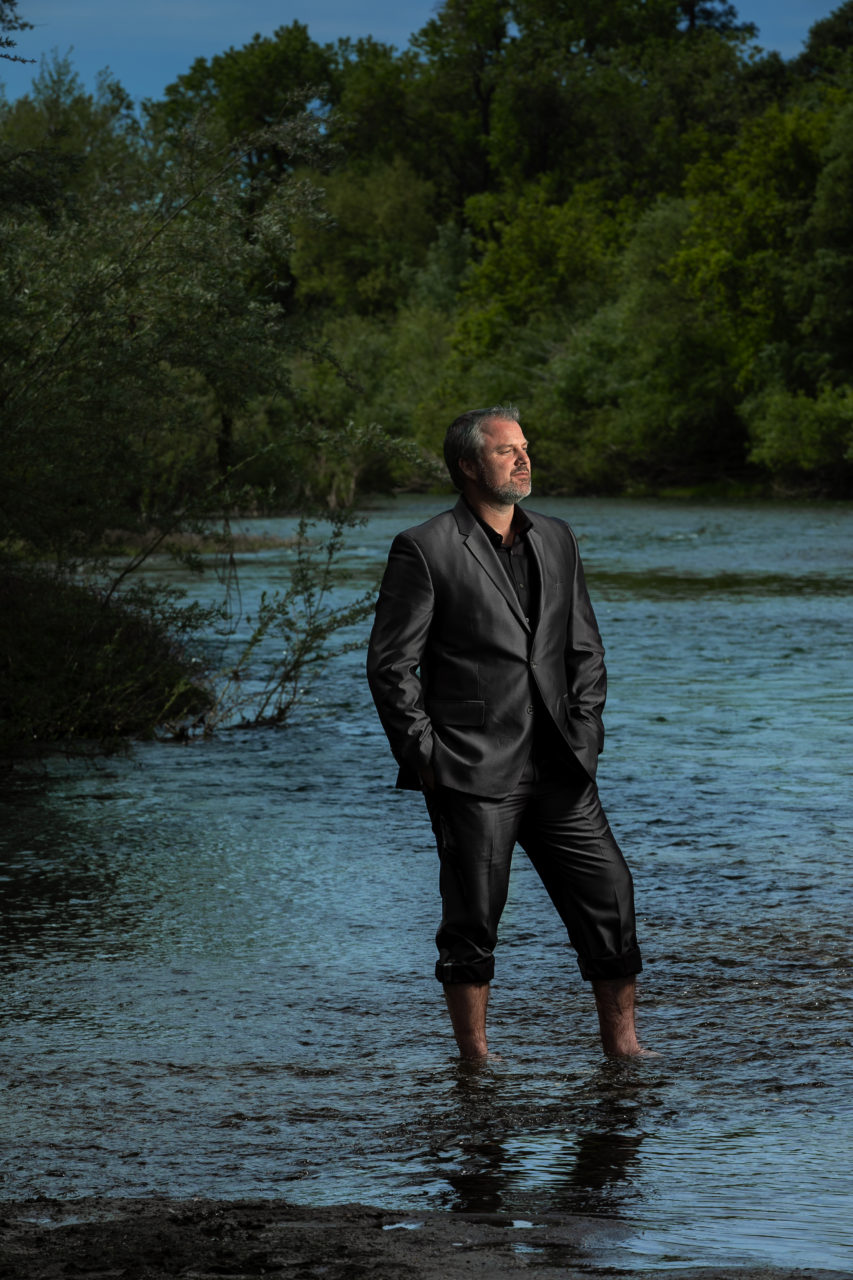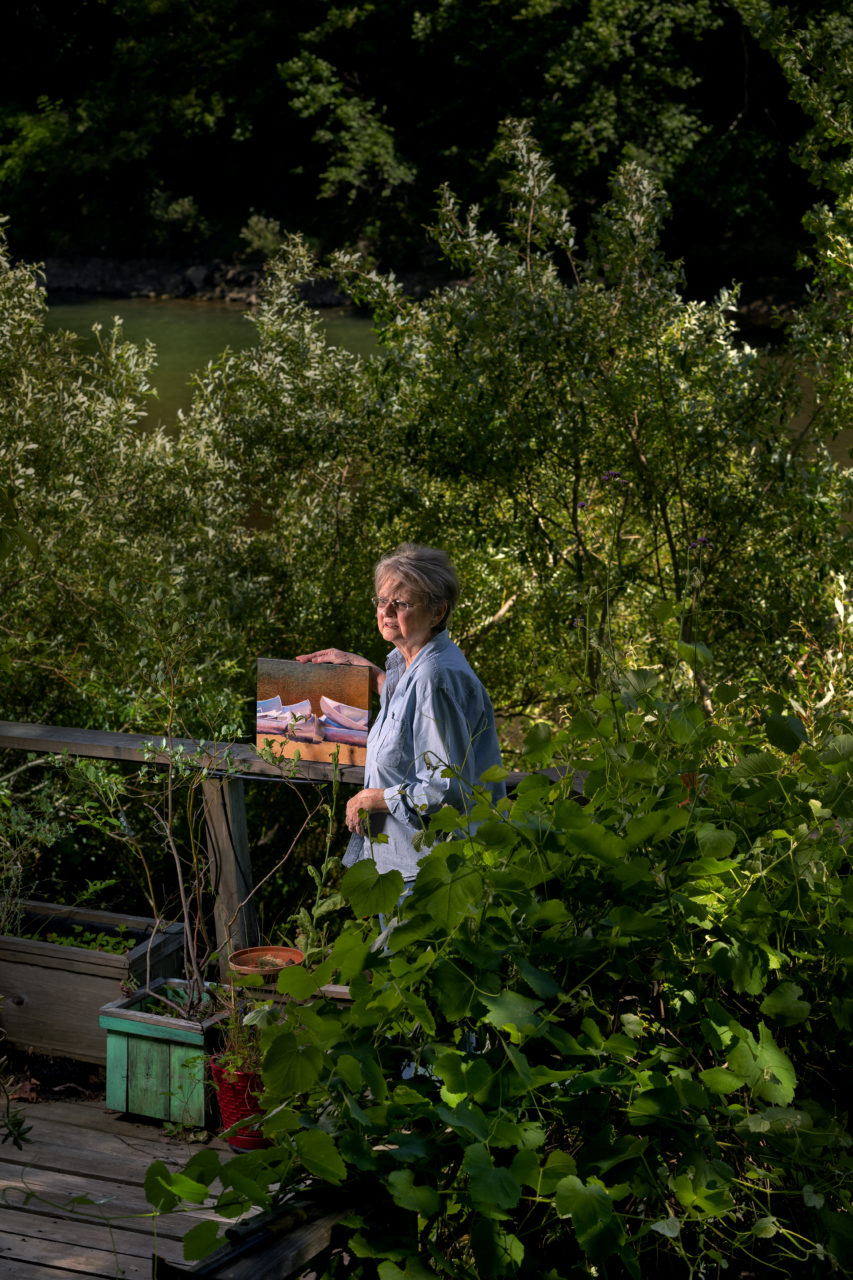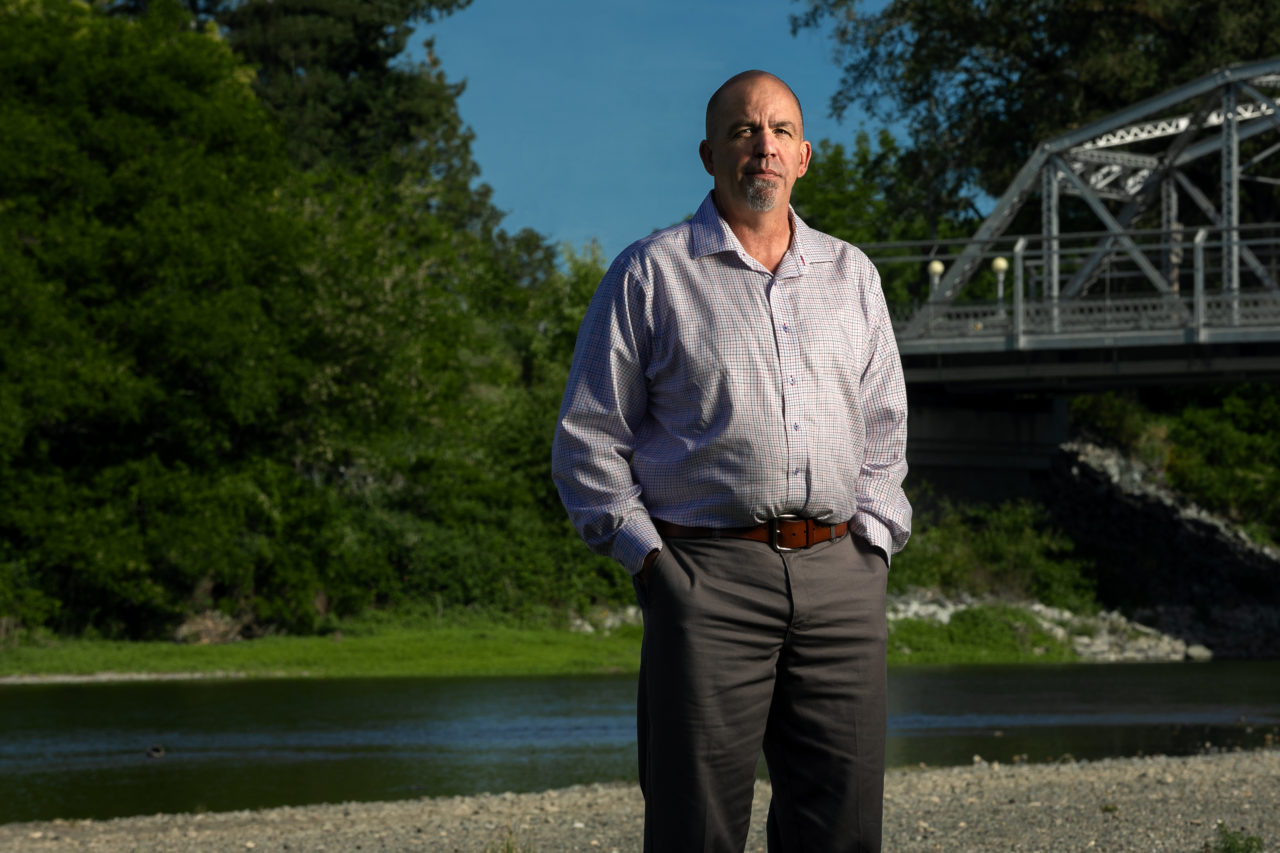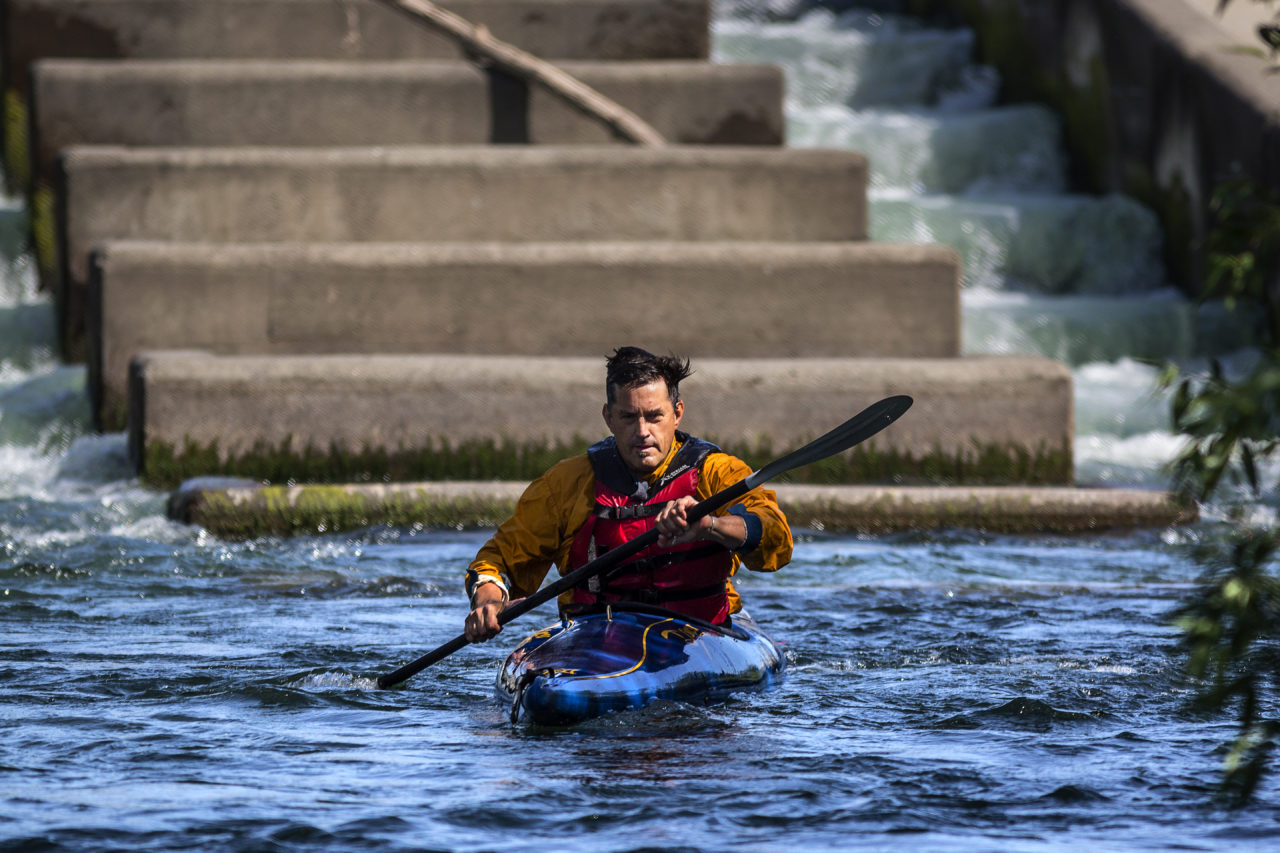Her oeuvre has earned her wide praise in the art world and acclaim from the American Academy of Arts and Letters. She has been compared to such luminaries as Wayne Thiebaud, whom she knew, and Thomas Eakins.
As Kenneth Baker, the art critic for the San Francisco Chronicle put it in one review, “… Though her images are sunlit and her colors sweet, Robertson’s vision is not falsely cheerful. People in her pictures often are depicted alone against stretches of water and shore, leading us to wonder whether they are alone as they appear…” That assessment rings true for Robertson.
“I don’t try to be cheerful,” she says. “If your paintings are felt, they show it.
To me, as a painter, human beings are part of the composition, they’re things on the beach, like the water and sand and trees.”
Her river paintings somehow subsume all elements, human and natural, into a larger whole, one that speaks first and foremost of place.
”It’s just the greenest, most beautiful place in the world,” says Robertson.
‘So it influences every aspect of your life. … There’s always this sound of water flowing over rocks. We’re hearing the river as well as seeing it.”
She has had to put down her brush in recent months due to illness, but she is recovering her strength and plans to take up again with her oils and watercolors soon. Recently, in her studio, she contemplated a completed study of several canoes pulled up on a Russian River beach. She mentioned her mentor, famed printmaker and painter Gordon Cook.
“Gordon once said that I had a marvelous feel for algae,” Robertson says with a faint smile. “I appreciated that.”
SEAN WHITE: Former Director of the Russian River Flood Control and Water Conservation Improvement District
Sean White led the way through heavy stands of mugwort and willow under the Highway 175 bridge outside Hopland. Quail called from the undergrowth and where the path ended at the water’s edge, the river was a narrow ribbon of green silk flowing between wooded banks.
It’s a beautiful and bucolic spot, but to White, the appearances aren’t necessarily encouraging. “Fifteen ago, you could stand at this point and see the bottom of the river in detail,” he says. “The water was crystal clear.”
White was the director of the Russian River Flood Control and Water Conservation Improvement District until 2015, and currently serves as the director of water and sewer for the City of Ukiah. He is an avid fishermen and kayaker, and his outings on the upper river have honed his understanding of its changing hydrology and ecology.
As White sees it, the main problem bedeviling water quality in this stretch of the Russian is Lake Mendocino, specifically Coyote Valley Dam at its mouth.
“There’s a lot of silt in the lake, and the dam is an old and simple design,” says White. “Warm Springs Dam at Lake Sonoma has several ports – you can release water from various levels along the dam. But Coyote Valley Dam only has one port — right at the bottom, where all the sediment is, and silt is just spewed into the river with the releases.
We could solve most of our sedimentation problems in this reach of the river by retrofitting the dam with multiple ports.”
White has also become an evangelist for a holistic, two-county approach to managing the various demands on the river, instead of the piecemeal system that lumps its resources into an aggregation of legal rights. He has even advised Ukiah to forgo a small contract for river water — a near heretical move in the water-hungry West — noting that the city has far more claim to water than it uses in a year. Not everyone in Ukiah is convinced. But White, a supporter of Supervisor Gore’s efforts with the Russian River Confluence, is unapologetic.
In 2016, “confluence members floated the Russian from its headwaters to the ocean,” recalls White. “I know the river well, but I’d never paddled the whole thing in one trip, and it really confirmed my sense that we need a generational plan that encompasses the entire watershed. And more than that, I think it’s inevitable. We’re heading that way, and I don’t think we’re going back.”
CRAIG ANDERSON: Co-Founder LandPaths
A fifth-generation Californian, Craig Anderson was concerned about protecting the signature landscapes of the Golden State at an early age, an interest that led to graduate studies in ecology at UC Berkeley. But his early work convinced him wildland preservation and restoration depended on getting people to care about the land.
“And the best way to do that is to get them on the land,” says Anderson, a vigorous, animated man in his mid-fifties who surfs and still enjoys skateboarding. “When you establish those bonds, stewardship follows.”
Anderson co-founded Santa Rosa-based LandPaths in 1996. Its mission was and remains simple: fostering connections between people and the landscapes of Sonoma County. Docents and guides lead outings through the county’s open spaces, promote volunteer wildlife habitat projects, tend a large community garden in Roseland, and manage extensive preserves, including a holding of redwoods near the lower Russian River and a forested tract on Fitch Mountain overlooking the river in Healdsburg.
“The Russian River is integral to everything we do,” says Anderson. “It defines our landscape, from the ridgetops to the lowest elevation of the watercourse, from its headwaters to the sea. We interact with the river at every elevation and at every point.”
By the same token, says Anderson, the river’s problems can’t be attributed to any single cause. No overarching villain exists. We all contribute to its ills and its health.
“It’s not just aggregate mining, or diversions for cities or vineyards, or sedimentation. It’s all those things. There used to be deep pools along the river that were formed from cold water seeping up. Hundreds of steelhead would over-summer in them. We’ve lost that, but it’s too easy to say ‘Oh, the vineyards did it.’ There are a lot of reasons, and they all reinforce each other. So we have to approach possible solutions in a way that addresses the whole watershed and all stakeholders, solutions that build on each other.”
The good news, says Anderson, is that rivers are resilient systems. With help, the Russian will bounce back.
“And we are getting serious about removing the insults,” he says. “It can be as dramatic as stopping gravel mining, or as subtle as planting willow whips in the bars and along the banks. We’re finally addressing flows in a serious way. We’re thinking of setback levees and meander belts. I think the Russian River of the future is going to be a much richer, healthier, more biodiverse system.”
The payoffs will go to nature and the people who engage with it, Anderson says.
“I see that in the kids I work with every day,” he says. “Initially, they have no real sense of what’s going on with the land because no one has really taken them out on it before. When they see how a forest is an interconnected web of everything from the bacteria in the duff to a redwood tree, when they see that a river is an aquatic analogue of the same thing, they become engaged. The more they learn, the more they care.”
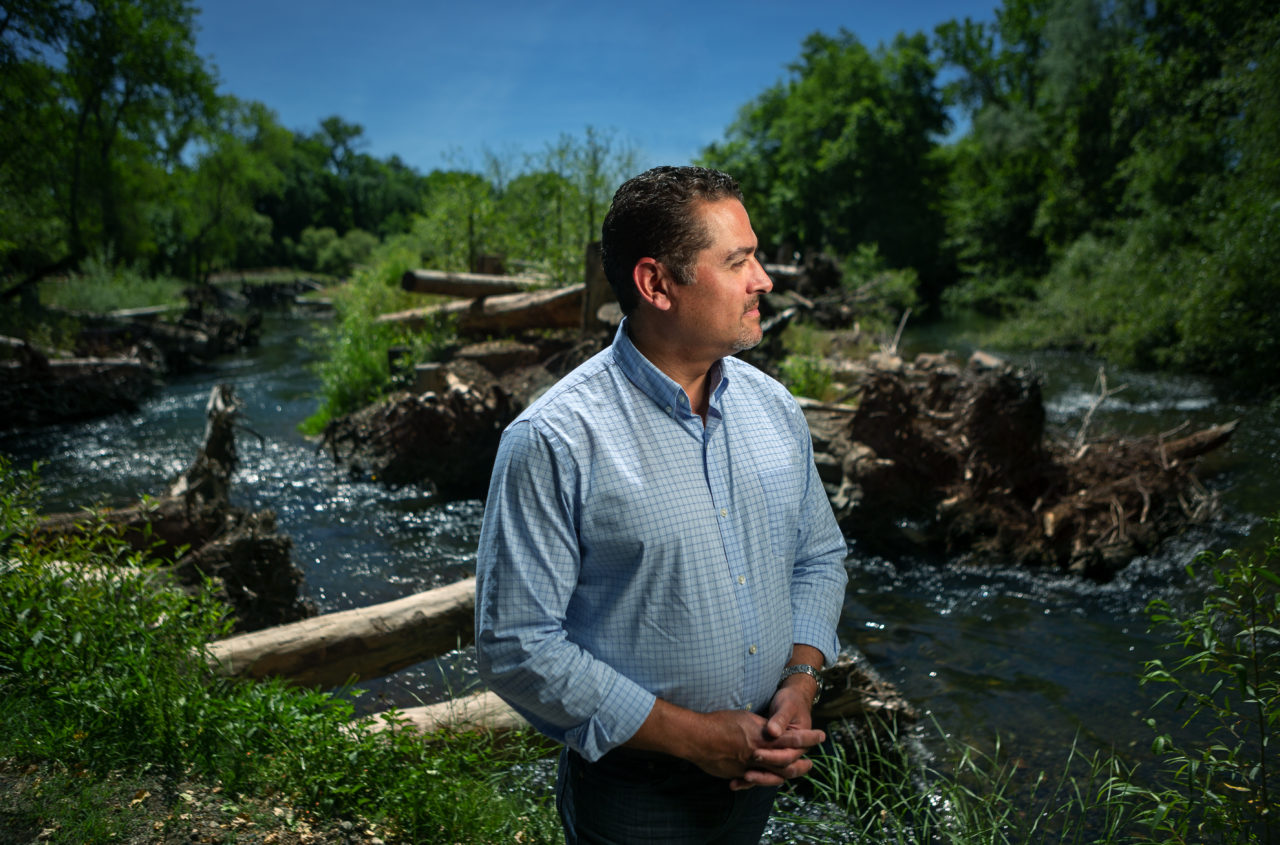
- Russian River Stewards: James Gore Reg Elgin Dan Poirier
DAVID MANNING: Environmental Resources Manager for the Sonoma County Water Agency
Just as the Russian River of old would be unrecognizable to most of us, its largest tributary, Dry Creek, has undergone vast changes over the decades.
A hundred years ago, the meandering creek took up the entire Dry Creek Valley, says David Manning, environmental resources manager for the Sonoma County Water Agency, which supplies Russian River drinking water to 600,000 people in Sonoma and northern Marin counties. “And as its name indicates, it had perennial flows — it was dry much of the year. But there were underflows back then that created deep pools that served as refuges for over-summering fish.”
The creek was harnessed for human needs starting at least 150 years ago, when orchards and vineyards constricted it to a narrow defile. Later, gravel mining cut off the creek from its historic flood plain. When the Warm Springs Dam was finished in the early 1980s — one of the last major dams erected in California — it further upended historic conditions, cutting off miles of spawning territory for steelhead and salmon while providing, clear, cold, and high-volume flows from the reservoir year-round.
In the past decade, with wild steelhead and salmon stocks still in decline, Dry Creek has been a focal point and laboratory for an ambitious publicprivate effort to bolster fish habitat — a $20 million effort to date to redress some of the man-made problems of the river system. It involves various local, state, and federal agencies, but its success is largely dependent on the good will of the valley’s grape growers.
“With 99 percent of the Dry Creek Valley in private hands, restoring healthy populations of salmon and steelhead requires active participation of the landowners,” says Manning, who oversees the project. “We’re lucky the response has been so positive.”
The work involves placing redwood stumps and logs in the creek and carving out side channels that have been lost over decades of human intervention. Up to 70 percent of the Dry Creek Valley’s property owners have bought into the plan, says Manning. About 2 miles of the creek have been rehabilitated to date, and the final number could be double that.
“We need clean gravel for returning fish to spawn on, lots of vegetation along the creek to cool the water, and enough structure and sheltered side channels to provide the nooks and crannies young fish need to hide, rest, and feed,” Manning says. “We’re attacking it in bite-sized pieces, but we’re making real progress.”
The creek already is responding in the best possible way. Thousands of mature king salmon and hundreds of endangered coho are returning to the creek, along with robust runs of steelhead.
“And they’re not just going to the hatchery,” Manning says. “There are some good spawning riffles now, and we’re seeing a lot of redds (nests created by spawning fish) right in the creek. There’s a lot we can do to rehabilitate the Russian River, but under any scenario, Dry Creek is going to be the major engine for fish restoration.”
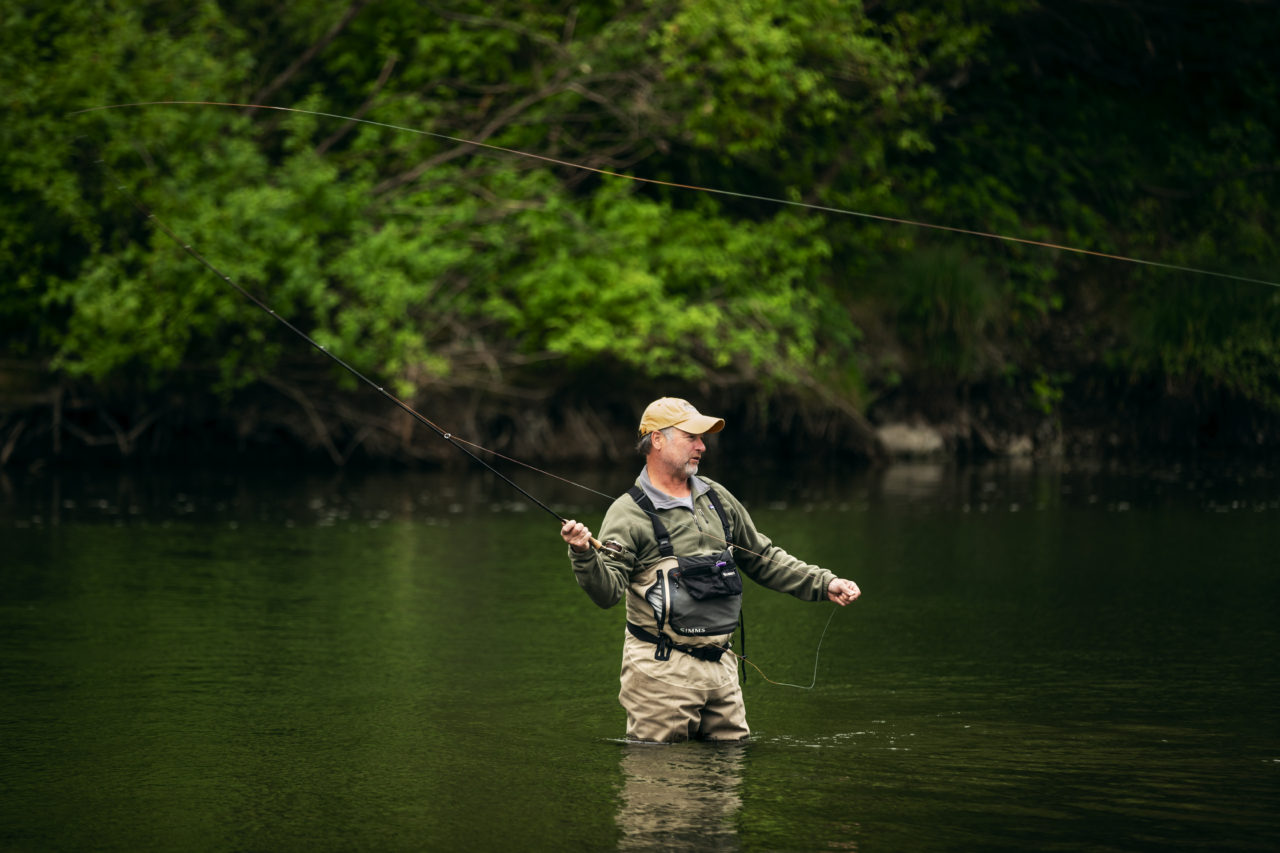
- Russian River steward and fisherman Bruce McDonnell
BRUCE MACDONELL: Project Manager of the Russian River Wild Steelhead Society
Bruce MacDonell’s roots in the lower Russian River go back to his great-grandparents, who bought the Guerneville property where he’s lived since 1986. “I’ve played on and fished this river since Iwas a little kid,” he says. “It’s always been a central part of my life.”
Like many residents of the lower river, MacDonell is somewhat fishbesotted. He is the project manager of the Russian River Wild Steelhead Society, an organization devoted to reviving the fortunes of the Russian River’s once prolific salmonid.
Celebrated for their size, the wild steelhead were imported to New Zealand more than a century ago, where their descendants comprise one of the finest sea-run trout fisheries in the world. In their natal river, things are far grimmer. While as many as 60,000 wild steelhead ran up the Russian River annually through the 1950s, numbers have dropped by more than 90 percent.
“We don’t have any illusions,” MacDonell says. “There’s no silver bullet for bolstering steelhead populations. The idea that we’ll someday have huge numbers of wild steelhead on the river again is probably unrealistic.
No matter how you look at things, the hatcheries will have to play a role in boosting fish populations. But we can manage things better — both in the hatcheries and in the watershed.”
MacDonell is enthused about advances in remote hatchery technology that should allow for a more discerning and successful efforts to prop up the wild runs. “By collecting fish from each little creek and then incubating their eggs in the same creeks, we hatch fish that are more like truly wild fish. They are likely to be tougher, more resilient, and better able to survive and return to spawn,” he says.
MacDonell also is heartened by extensive, multimillion-dollar fish habitat work now underway on Dry Creek, and he says that the Austin Creek watershed on the lower river is both holding its own and would benefit from restoration projects.
“A lot of work has been done on Dry Creek to bring coho salmon back, and they’re having some significant success,” says MacDonell. “Coho are more sensitive than steelhead, so anything that benefits them will also benefit steelhead.”
The future of the river’s once-famed runs depends on adequate flows in the summer and early fall, he says, and riparian vegetation to cool the water and provide shade.
“The great thing about steelhead is that they have the ability to rebound,” says MacDonell. “If we had three more winters [like 2016-2017], for example, they’d skyrocket. We know how to bring them back. We just need the will to do it.”
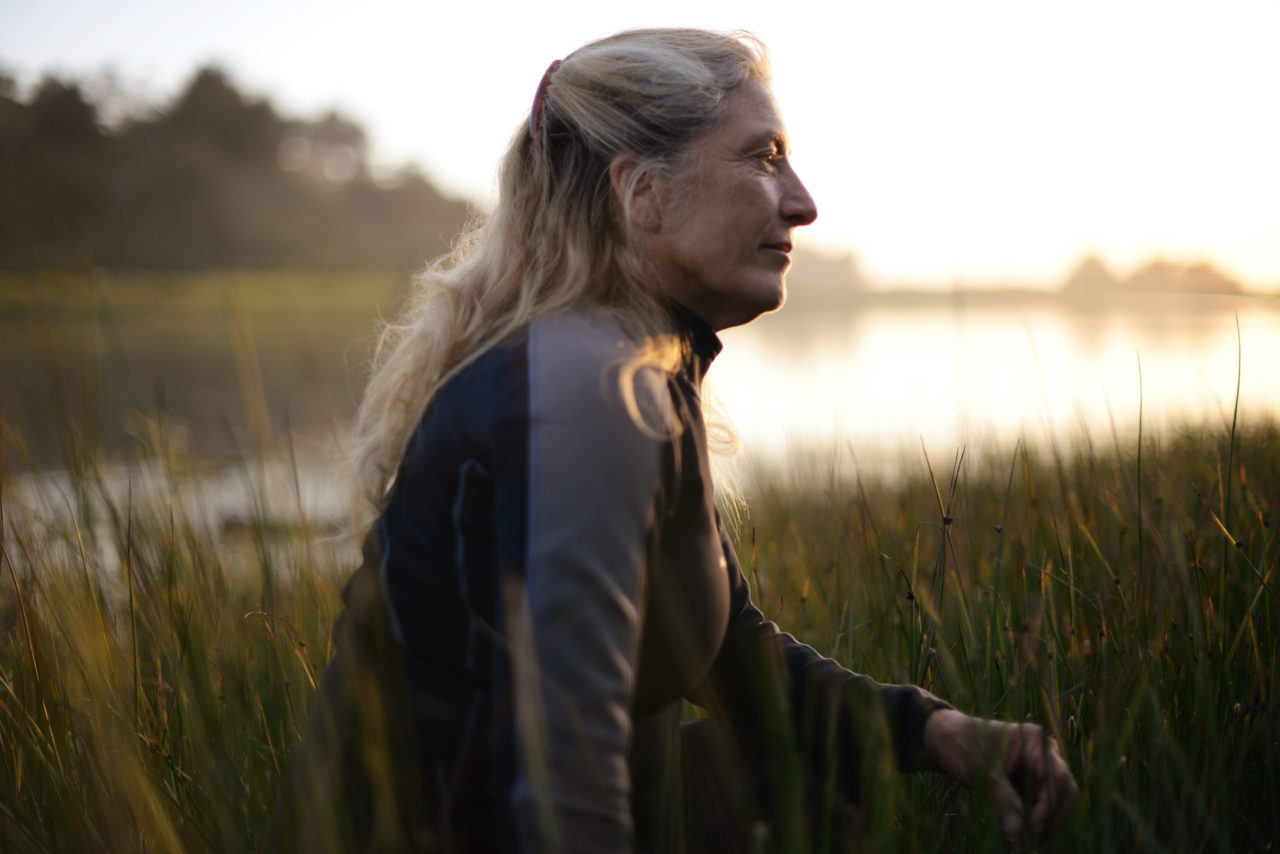
- “The lower Russian River was always central to Kashaya Pomo life, and it remains central to my life.” (Photo by Erik Castro)
SUKI WATERS: Founder Living Classrooms Project
The estuary of the Russian River is home for Suki Waters, just as it was home for generations of her ancestors.
“I went to the one-room school house in Jenner until it closed,” says Waters. “My Uncle Pio was the last farmer to cultivate Penny Island. My great-great-grandmother was born in the Kashaya Pomo village at Goat Rock, and was on the matriarch’s council. The lower Russian River was always central to Kashaya Pomo life, and it remains central to my life.”
Waters grew up along the river and the surrounding headlands, beaches, and forests, often helping her relatives forage for fish, shellfish, and edible plants.
“We caught cabezon and gathered abalone,” Waters recalled. “My uncle grew root crops and greens, and raised chickens and hogs. There were still good salmon and steelhead runs back then. The river provided for us.”
And the river still provides. Waters is the owner of WaterTreks Ecotours, a kayak rental and outfitting company that operates along the lower river.
Revenue from the business supports her other big venture, the Living Classrooms Project, a program that introduces kids to the Russian River’s ecosystems and native fauna and flora.
“Our Living Classrooms Project is particularly important for creating the next generation of advocates and guardians, the people who will continue to do the hard work of protecting the river,” Waters says. “Plus, I’m inspired by their enthusiasm. I love teaching them.”
Waters participates in two citizen watch groups monitoring wildlife and water quality along the Sonoma Coast, and she belongs to Stewards of the Coast and Redwoods, a nonprofit organization that helps manage and interpret numerous State Parks sites along the coast and lower river.
She also serves as an unofficial guardian of the large harbor seal rookery at the river’s mouth.
“Harbor seals need to spend a lot of their time resting to maintain health, and they become extremely stressed if they’re disturbed by human beings or dogs,” Waters said. “I’m pretty proud of the fact that my clients never disturb the seals, and even advise other paddlers about avoiding them. But it really bothers me when I see other people approaching or even harassing them. They’re so vulnerable.”
Waters’ role as an environmental steward has exposed to her to the river’s gravest losses. During her childhood, she recalls, there was more of everything: salmon, crabs, the kelp that sustains a wide array of marine life, from abalone to rockfish.
“And it’s not that there are just fewer fish,” she says. “They’re smaller. I remember catching really big cabezon, and it was common to catch ling cod 3 feet long. And the eels (lampreys) just swarmed up the river. That drove the seals and sea lions crazy — they love to eat them.”
But the lower Russian is still a river of riches. Almost 400 harbor seals now inhabit the rookery, seabirds and waterfowl remain abundant, and big schools of anchovies congregate near the mouth, drawing dolphins and whales.
“I’ve seen humpback and gray whales feeding 30 feet from the beach,” Waters says, “and right now, the shad are running up the river. You’re paddling along, the water is flat and calm, and then these big, silver fish start jumping out of the water. It’s incredibly beautiful.”



























